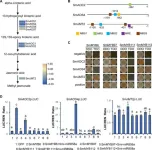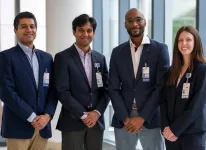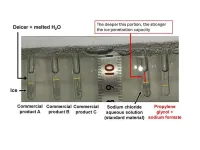(Press-News.org) Thousands of particles of light can merge into a type of “super photon” under suitable conditions. Physicists call such a state a photon Bose-Einstein condensate. Researchers at the University of Bonn have now shown that this exotic quantum state obeys a fundamental theorem of physics. This finding now allows one to measure properties of photon Bose-Einstein condensates which are usually difficult to access. The study has been published in the journal Nature Communications.
If many atoms are cooled to a very low temperature confined in a small volume, they can become indistinguishable and behave like a single “super particle.” Physicists also call this a Bose-Einstein condensate or quantum gas. Photons condense based on a similar principle and can be cooled using dye molecules. These molecules act like small refrigerators and swallow the “hot” light particles before spitting them out again at the right temperature.
“In our experiments we filled a tiny container with a dye solution,” explains Dr. Julian Schmitt from the Institute of Applied Physics at the University of Bonn. “The walls of the container were highly reflective.” The researchers then excited the dye molecules with a laser. This produced photons that bounced back and forth between the reflective surfaces. As the particles of light repeatedly collided with dye molecules, they cooled down and finally condensed into a quantum gas.
Super photons flicker like a candle
This process still continues afterwards, however, and the particles of the super photon repeatedly collide with the dye molecules, being swallowed up before being spat out again. Therefore, the quantum gas sometimes contains more and sometimes less photons, making it flicker like a candle. “We used this flickering to investigate whether an important theorem of physics is valid in a quantum gas system,” says Schmitt.
This so-called “regression theorem” can be illustrated by a simple analogy: Let us assume that the super photon is a campfire that sometimes randomly flares up very strongly. After the fire blazes particularly brightly, the flames slowly die down and the fire returns to its original state. Interestingly, one can also cause the fire to flare up intentionally by blowing air into the embers. In simple terms, the regression theorem predicts that the fire will then continue to burn down in the same way as if the flare up had occurred at random. This means that it responds to the perturbation in exactly the same way as it fluctuates on its own without any perturbation.
Blowing air into a photon fire
“We wanted to find out whether this behavior also applies to quantum gases,” explains Schmitt, who is also a member of the transdisciplinary research area (TRA) “Building Blocks of Matter” and the “Matter and Light for Quantum Computing” Cluster of Excellence at the University of Bonn. For this purpose, the researchers first measured the flickering of the super photons to quantify the statistical fluctuations. They then – figuratively speaking – blew air into the fire by briefly firing another laser at the super photon. This perturbation caused it to briefly flare up before it slowly returned to its initial state.
“We were able to observe that the response to this gentle perturbation follows precisely the same dynamics as the random fluctuations without a perturbation,” says the physicist. “In this way we were able to demonstrate for the first time that this theorem also applies to exotic forms of matter as quantum gases.” Interestingly, this is also the case for strong perturbations. Systems usually respond differently to stronger perturbations than they do to weaker ones – an extreme example is a layer of ice that will suddenly break when the load placed on it becomes too heavy. “This is called nonlinear behavior,” says Schmitt. “However, the theorem remains valid in these cases, as we have now been able to demonstrate together with our colleagues from the University of Antwerp.”
The findings are of huge relevance for fundamental research with photonic quantum gases because one often does not know precisely how they will flicker in their brightness. It is much easier to determine how the super photon responds to a controlled perturbation. “This allows us to learn about unknown properties under very controlled conditions,” explains Schmitt. “It will enable us, for example, to find out how novel photonic materials consisting of many super photons behave at their core.”
Participating institutes and funding:
The Institute of Applied Physics at the University of Bonn, the University of Antwerp (Belgium) and the University of Freiburg participated in the study. The project was supported by the German Research Foundation (DFG), the European Union (ERC Starting Grant), the German Aerospace Centre (DLR) and the Belgium funding agency FWO Flanders.
Publication: Alexander Sazhin, Vladimir N. Gladilin, Andris Erglis, Göran Hellmann, Frank Vewinger, Martin Weitz, Michiel Wouters and Julian Schmitt: Observation of nonlinear response and Onsager regression in a photon Bose-Einstein condensate; Nature Communications;
https://doi.org/10.1038/s41467-024-49064-9
Contact:
Dr. Julian Schmitt
Institute of Applied Physics
University of Bonn
Tel. +49 228 73-60122
E-mail: schmitt@iap.uni-bonn.de
END
Perturbations simplify the study of “super photons”
A study by the University of Bonn gives novel insight into properties which are often difficult to observe
2024-06-07
ELSE PRESS RELEASES FROM THIS DATE:
Decoding salvia miltiorrhiza: a molecular approach to boosting bioactive compounds
2024-06-07
Salvia miltiorrhiza, known as Danshen, is widely used in traditional Chinese medicine for treating cardiovascular diseases, cancer, and Alzheimer's disease. The medicinal properties of Danshen are primarily attributed to its two major bioactive compounds: tanshinones and phenolic acids. Despite their importance, the genetic and regulatory mechanisms underlying their biosynthesis remain poorly understood. Based on these challenges, there is a pressing need for in-depth research to uncover the molecular pathways involved in the production of these ...
Digital babies created to improve infant healthcare
2024-06-07
Researchers at University of Galway have created digital babies to better understand infants’ health in their critical first 180 days of life.
The team created 360 advanced computer models that simulate the unique metabolic processes of each baby.
The digital babies are the first sex-specific computational whole-body models representing newborn and infant metabolism with 26 organs, six cell types, and more than 80,000 metabolic reactions.
Real-life data from 10,000 newborns, including sex, birth weight and metabolite concentrations, enabled the creation and validation ...
Lavender's secret: genetic regulator boosts plant health and fragrance output
2024-06-07
A groundbreaking study has identified a gene that plays a dual role in enhancing both the aromatic compounds and disease resistance in lavender plants. The research uncovers how the LaMYC7 gene positively regulates the biosynthesis of linalool and caryophyllene, key for lavender's scent and its resistance to common plant pathogens.
Plants face various environmental pressures, including biotic stressors like pathogens and abiotic stressors such as extreme temperatures. Among biotic stressors, Pseudomonas syringae significantly threatens plant health worldwide. Terpenoids, including linalool and caryophyllene, play crucial roles in plant ...
How $4 billion funded the unprecedented COVID-19 pandemic response
2024-06-07
New University of Virginia School of Medicine research is shedding light on how federal funding helped scientists understand the COVID-19 virus, develop new treatments and deploy lifesaving vaccines in record time.
The UVA Health researchers used advanced “machine learning” – a form of artificial intelligence – to analyze the thousands of scientific publications that resulted from the National Institutes of Health’s deployment of more than $4 billion to combat the pandemic. This analysis allowed the researchers to categorize the types ...
Advances in omics research of rosaceae
2024-06-07
A research team has provided a comprehensive overview of the applications of omics technologies in Rosaceae plants. The study highlights significant advancements in genome sequencing, transcriptome, proteomics, and metabolomics, shedding light on the genetic regulatory mechanisms underlying crucial traits such as flower color, fragrance, stress tolerance, and fruit quality. This research is invaluable for molecular breeding and improving economic traits in Rosaceae plants, potentially leading to the rapid cultivation of new varieties and germplasm.
The Rosaceae family, with its diverse species and economic importance, is a focus ...
Basic research: Inhibition of epigenetic control enzymes in immune cells as a potential new starting point in cancer immunotherapy
2024-06-07
Immunotherapy is one of the pillars in the fight against cancer and aims to enable the body's own immune system to fight a tumor. A recent study now shows that removing certain enzymes that regulate epigenetic processes from the so-called dentritic cells of the immune system influences their development and thus improves anti-tumor immunity. This finding could lead to new therapeutic strategies in immunotherapy. The study by Cristiano De Sá Fernandes from Maria Sibilia's research group at the Center for Cancer Research and the Comprehensive Cancer Center of MedUni Vienna and Vienna General Hospital was recently published in Cell Reports.
Cancer cells are the body's ...
Tracking greenhouse gas emissions in Chinese value chains with an interprovincial input–output model
2024-06-07
China’s economy has shifted from a stage of high growth to a stage of high-quality development, and the establishment of a dual-carbon target requires profound changes in the industrial structure and energy systems, as well as finding the right direction and pathway for industrial adjustment. While the potential for technological emission reduction continues to be released, the main factor affecting China’s carbon emissions is the speed and intensity of economic transformation and industrial restructuring.
A research team of Dr. GU Alun from Tsinghua University in Beijing, China, recently analyzed the correlations ...
Earth and space share the same turbulence
2024-06-07
Fukuoka, Japan—In a paper published in Geophysical Research Letters, researchers have discovered that the turbulence in the thermosphere exhibits the same physical laws as the wind in the lower atmosphere. Furthermore, wind in the thermosphere predominantly rotates in a cyclonic direction, in that it rotates counterclockwise in the Northern Hemisphere and clockwise in the Southern Hemisphere.
The findings reveal a new unified principle for the Earth’s varied environmental systems and can potentially improve future forecasting of both earth and space weather.
One time or another we’ve tuned in to see the latest weather forecast, and while ...
With programmable pixels, novel sensor improves imaging of neural activity
2024-06-07
Neurons communicate electrically so to understand how they produce brain functions such as memory, neuroscientists must track how their voltage changes—sometimes subtly—on the timescale of milliseconds. In a new paper in Nature Communications, MIT researchers describe a novel image sensor with the capability to substantially increase that ability.
The invention led by Jie Zhang, a postdoctoral scholar in The Picower Institute for Learning and Memory lab of Sherman Fairchild Professor Matt ...
Frozen? Let it melt with efficient new deicer friendly to the environment
2024-06-07
The dangers of frozen roads, airplane engines, and runways are well known, but the use of commercial products often means short-term safety over long-term environmental degradation. Seeking a better product, Osaka Metropolitan University researchers have developed a deicing mixture offering higher performance than deicers on the market while also having less impact on the environment.
The team, made up of graduate student Kai Ito, Assistant Professor Arisa Fukatsu, Associate Professor Kenji Okada, and Professor Masahide Takahashi of the Graduate School of Engineering, used machine learning to analyze ice melting mechanisms of aqueous solutions of 21 salts and 16 organic ...
LAST 30 PRESS RELEASES:
What causes some people’s gut microbes to produce high alcohol levels?
Global study reveals widespread burning of plastic for heating and cooking
MIT study shows pills that communicate from the stomach could improve medication adherence
Searching for the centromere: diversity in pathways key for cell division
Behind nature’s blueprints
Researchers search for why some people’s gut microbes produce high alcohol levels
Researchers find promising new way to boost the immune response to cancer
Coffee as a staining agent substitute in electron microscopy
Revealing the diversity of olfactory receptors in hagfish and its implications for early vertebrate evolution
Development of an ultrasonic sensor capable of cuffless, non-invasive blood pressure measurement
Longer treatment with medications for opioid use disorder is associated with greater probability of survival
Strategy over morality can help conservation campaigns reduce ivory demand, research shows
Rising temperatures reshape microbial carbon cycling during animal carcass decomposition in water
Achieving ultra-low-power explosive jumps via locust bio-hybrid muscle actuators
Plant-derived phenolic acids revive the power of tetracycline against drug-resistant bacteria
Cooperation: A costly affair in bacterial social behaviour?
Viruses in wastewater: Silent drivers of pollution removal and antibiotic resistance
Sub-iethal water disinfection may accelerate the spread of antibiotic resistance
Three in four new Australian moms struggle with body image
Post-stroke injection protects the brain in preclinical study
Cardiovascular risk score predicts multiple eye diseases
Health: estimated one in ten British adults used or interested in GLP-1 medications for weight loss
Exercise to treat depression yields similar results to therapy
Whooping cough vaccination for pregnant women strengthens babies’ immune system
Dramatic decline in new cases of orphanhood in Uganda driven by HIV treatment and prevention programs
Stopping weight loss drugs linked to weight regain and reversal of heart health markers
Higher intake of food preservatives linked to increased cancer risk
Mass General Brigham–developed cholera vaccine completes phase 1 trial
First experimental validation of a “150-year-old chemical common sense” direct visualization of the molecular structural changes in the ultrafast anthracene [4+4] photocycloaddition reaction
Lack of support for people on weight loss drugs leaves them vulnerable to nutritional deficiencies, say experts
[Press-News.org] Perturbations simplify the study of “super photons”A study by the University of Bonn gives novel insight into properties which are often difficult to observe







